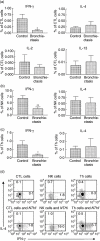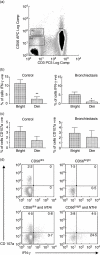Cytotoxic T lymphocyte and natural killer cell responses to non-typeable Haemophilus influenzae
- PMID: 18462210
- PMCID: PMC2453218
- DOI: 10.1111/j.1365-2249.2008.03667.x
Cytotoxic T lymphocyte and natural killer cell responses to non-typeable Haemophilus influenzae
Abstract
Cytotoxic T lymphocytes (CTL) and natural killer (NK) cells have a key role in host defence against infectious pathogens, but their response to bacteria is not well characterized. Non-typeable Haemophilus influenzae is a major cause of respiratory tract infection including otitis media, sinusitis, tonsillitis and chronic bronchitis (especially in chronic obstructive pulmonary disease and bronchiectasis). This bacterium is also present in the pharynx of most healthy adults. The primary factor that may determine whether clinical disease occurs or not is the nature of the lymphocyte response. Here we examined the CTL cell and NK cell responses to nontypeable H. influenzae in healthy control subjects and in subjects who had bronchiectasis and recurrent bronchial infection with this bacterium. Cells were stimulated with live H. influenzae and intracellular cytokine production and release of cytotoxic granules measured. Control subjects had significantly higher levels of interferon gamma production by both CTL and NK cells, while levels of cytotoxic granule release were similar in both groups. The main lymphocyte subsets that proliferated in response to H. influenzae stimulation were the CTL and NK cells. The results suggest that CTL and NK cell responses may be important in preventing disease from nontypeable H. influenzae infection.
Figures






References
-
- Wong P, Pamer EG. CD8 T cell responses to infectious pathogens. Annu Rev Immunol. 2003;21:29–70. - PubMed
-
- Weycker D, Edelsberg J, Oster G, Tino G. Prevalence and economic burden of bronchiectasis. Clin Pulm Med. 2005;4:205–9.
-
- Murphy TF. Haemophilus infections. In: Braunwald E, Fauci A, Kasper D, Hauser S, Longo D, Jameson J, editors. Harrison's principles of internal medicine. 15. New York: McGraw-Hill; 2001. pp. 939–42.
-
- St Geme JW., III Insights into the mechanism of respiratory tract colonization by nontypable Haemophilus influenzae. Pediatr Infect Dis J. 1997;16:931–5. - PubMed
MeSH terms
Substances
LinkOut - more resources
Full Text Sources
Medical

